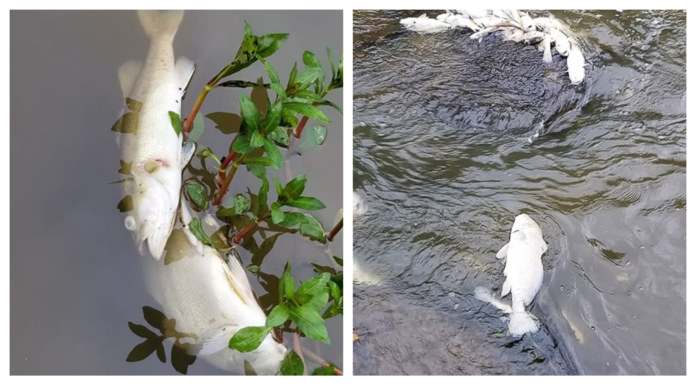
Updated 6-11-19 8:32 a.m.
HANCEVILLE, Ala. – The June 6 spill of “partially treated effluent” (liquid waste or sewage) into the Dave Young Creek, which flows into the Mulberry Fork, by the Tyson Foods, Inc. Hanceville rendering plant, (formerly owned by American Proteins), provoked anger and fear among residents along the river, and among environmental activists- but it did not seem to surprise anyone. Witnesses to this incident told The Cullman Tribune: “It’s not the first time.”
In August 2016, American Proteins spilled 900 gallons of sulfuric acid into the river at approximately the same point where last week’s spillage took place. In May and June 2015, American Proteins accidentally released 80,000 gallons of wastewater into the river at the same location. The company was fined $50,000 by the Alabama Department of Environmental Management (ADEM) for the two incidents. (www.cullmantribune.com/2016/12/01/updated-american-proteins-to-pay-50000-fine-for-violations-including-mulberry-fork-acid-spill)
The plant was also the source of a spill in 2011, which was attributed to damage from the April 27 tornadoes. The company was not charged or fined.
All three events resulted in fish kills, but residents say last Thursday’s event looks bigger than any of the previous incidents.
Indirect notice omits Tyson name
On Friday morning, the day after the spill, The Tribune received this public notice:
This is a notice to the general public: on June 6, 2019, due to a failure in a pipe owned by River Valley Ingredients located near Hanceville, Alabama, partially treated effluent is believed to have reached the Dave Young creek, which flows to the Mulberry Fork.
River Valley Ingredients acted quickly and is engaged with the Alabama Department of Environmental Management and has an environmental management company actively working on clean-up. The company is dedicated to swift remediation of this issue.
In an abundance of caution, the public is encouraged to avoid recreating in Dave Young creek or the Mulberry Fork until further notice.
The notice was sent out by Worth Sparkman, Tyson’s senior manager for public relations. River Valley Ingredients is a trademark owned by Tyson Foods, whose local business address is the same as the chicken plant. On the trademark page of Justia.com, its business is described as producing animal feed from feather meal and chicken by-product meal.
Where does the Mulberry Fork go?
The Mulberry Fork begins in northeast Cullman County below Arab, then flows to the southwest, forming a portion of the boundary between Cullman and Blount Counties. In western Walker County, it is joined by the Sipsey Fork and flows south to man-made Bankhead Lake at the junction of Walker, Jefferson and Tuscaloosa Counties, where it meets the Locust Fork. Together, they flow out of the lake to the southwest as the Black Warrior River, through Tuscaloosa to the Tombigbee River and south to Mobile.
The City of Birmingham Water Works Board draws water from the north end of Bankhead Lake to feed its Western and Putnam filter plants and deliver water to approximately 200,000 customers in Jefferson and four other counties.
Contamination in the tributaries of the Black Warrior can potentially affect wildlife, outdoor recreation, private homes and businesses, and water quality along a corridor from Cullman and Walker Counties through west and southwest Alabama to Mobile and the Gulf Coast, including the cities of Birmingham, Tuscaloosa and many other municipalities.
Residents react
On Saturday morning, Keith Fink, who lives on the Mulberry Fork, shot photos and videos near his home, then took to social media. Mentioning the 2016 acid spill, he went on to write:
“What ever they poured in the water this time has had a greater impact on the rivers ecosystem. This (see photos) is 14 miles down stream from the plant. Fish have been turning up for days with a steady stream floating down. Every size of every kind of fish. There is no telling how this might (impact) the waters further down steam. American (Protein) a Tyson company needs to pay up and They need to help build this beautiful river back up.”
In his post, Fink concluded, “They need more than just a slap on the wrist. This is the 3rd fish kill on the same river I know of. All because of the same plant. Something needs to be done.”
Michael Cates, who has a farm on the river near the junction of Cullman, Blount and Walker Counties approximately 20 miles downstream from the Tyson plant, told The Tribune:
“I’m 42. I’ve lived here my whole life . . . My grandfather bought this place back in the 50s, and my family’s been there for generations. And we’ve had kills like this before from American Proteins, but it just started really getting out there, you know, with the popularity of social media and stuff like that.
“What they’ve done this time is just more catastrophic than the acid spill in ‘16. It’s just ridiculous, and it seems like that they’ll fine them 15, 20 thousand dollars, and then they’ll let them go on about their business; then, a few years later, here comes another big leak which, you know tells us it’s a maintenance issue.
“And now that Tyson owns it, you would think they could put enough money into their maintenance to prevent these things from happening.”
Cates continued, “It’s just ridiculous, you know. My dad, he passed away in 2016, and he was 61. He was born and raised on that river, and he wouldn’t even eat fish that come out of the river on account of American Proteins. It’s just ridiculous.
“What don’t get reported is the green film that comes down the river. They’ve been polluting the river for generations. And now they say that they’ve got a cleanup crew doing this one here, but what they’re not telling people is the after-effects. We fish that river: we stock our freezers up every summer for the winter, and, you know, I fish all during the summer and I stock my freezer up with it. And now, you know, our damn dogs can’t even drink out of the river, in fear that they’re going to die.
“If you think about it, we’re 20 miles downstream, and we’ve got crawfish crawling on the banks and dying. A friend of mine sent a video down below us, and had probably a 20- or 25-pound flathead catfish come to the air, just swimming in circles, dying. So, the long-term effect is- they’re saying they’re cleaning it up, but yeah, they clean it up, but how long is it going to be before we can eat fish out of the river? Because I can tell you, six months from now, I’m not going to eat a catfish that survived this. They’re not talking about the long-term effects of it.
“You know, they’re saying cease recreation(al) use, but what about all of us that live on the river, that have animals that drink out of that river. There’s just more to the story than they’re wanting to put out.”
Roger Perkins lives on the Blount County side of the Mulberry Fork, about 14 miles downstream from the plant. He told The Tribune about the amount of dead fish he saw in the river:
“It was huge. I’ve never seen nothing this big, and I’ve been here 30 years, approximately, on this river. And this is not the first time it’s happened, but it’s definitely the biggest.
“Friday morning- I can see the water from where I live- and Friday morning I was watching. You know, I thought, ‘That looks strange.’ All the fish was on top of the water, you know, and they was dying. But they was swimming around with their mouth like on top of the water: these catfish and bream, and I mean every species. And I said, ‘I believe these fish are dying.’ I got to looking, and Friday morning, this far down, they was dying here. But I didn’t see no dead fish at that moment till I got to noticing some little minnows, you know, little fish.
“But Friday, I was watching 20-pound catfish and bream, and, you know, everything was dying. It was like they couldn’t get no oxygen. And like I said, I’m way downriver, you know.”
“One (catfish) probably weighed 30 or 40 pounds. And I’m up high, you know; I’m probably 50 foot above the river, looking down. This big catfish- I’ll tell you what it reminds me of: it looked like one of them whale sharks you see in the ocean, just holding his mouth open. I watched him die. He swam around for probably an hour, and he’d get right against the bank and then he’d swim out toward the middle. And that’s what they was all doing. But that one fish, I could see him so good because he was so big . . . He had his mouth open the whole time, just swimming right on.
“He was dying, you know, and I watched him. He finally got about 3 foot off the bank and he just bellied up.”
Perkins described a patch of rocky shoals in the river near his home where dead fish were “stacked up like cordwood.”
Said Perkins, “It’s a huge fish kill. But this is not the first time, you know. And something needs to be done, and I don’t know what we can do about it.”
Later in our conversation, Perkins posed the question, “What’s the long-term effect? I mean, there’s a lot of questions I’d like to get answered, you know. And they just slap them on the hand. I think that last time, somebody said, it was something like a $50,000 fine. Do you realize that’s just over a dollar a fish? And they estimated 40,000. I know there’s no way to count them, but that is ridiculous, in my opinion.
“You know what? I’m a fisherman, and I do abide by their laws, you know. But it’s sickening to know- because I’ve heard people say like at Smith (Lake), if you get caught with a fish that’s not in the limit, it’s a $300 fine for one fish, per fish, you know. And I think, well, you know, they’re killing all these fish in the Mulberry. Why not give them the same?”
Perkins also pointed out that fish are only part of the equation. Crawfish are common in the Mulberry Fork, and numerous birds and land animals live off of the resources the river ecosystem provides.
“What all is it going to affect?” wondered Perkins. “You know, I’m not concerned about the money issue. But there’s a lot of questions that need to be answered, I think.”
Perkins concluded, “I bought here to enjoy this river, and here lately, I’m scared to even get out in it.”
Black Warrior Riverkeeper responds
On Friday afternoon, Black Warrior Riverkeeper representative Nelson Brooke sent this statement to The Tribune:
American Proteins had a large wastewater spill (undisclosed amount) sometime yesterday, which caused a massive fish kill. The Alabama Department of Conservation and Natural Resources’ Division of Wildlife & Freshwater Fisheries (DCNR) and the Alabama Department of Environmental Management (ADEM) are conducting an investigation into the wastewater spill and resulting fish kill today. Unfortunately, everyone should avoid contact with the Mulberry Fork downstream until further notice.
American Proteins [1170 Co. Rd. 508 | Hanceville, AL 35077 (256) 352-9821)], which they say is the largest rendering plant in the world, is now owned by Tyson. The sprawling plant receives chicken carcasses from slaughterhouses across Alabama and cooks them down into protein products. This facility has a history of spills and fish kills due to poor housekeeping and maintenance.
ADEM is responsible for holding American Proteins accountable for the spill, and should levy a stiff penalty to encourage better housekeeping and deter future spills and fish kills. ADEM failed to issue a stiff penalty in 2016 when American Proteins spilled 900 gallons of sulfuric acid into the river, killing around 40,000 fish. The fine levied by ADEM for that spill and kill was a mere slap on the wrist. Join us in demanding that ADEM hold American Proteins accountable!
On Sunday, The Tribune followed up with Brooke for an update, and he shared, “It might come as a surprise that ADEM, EPA and industry are not readily sharing with us step by step what’s going on. But typically, we have to do a lot of digging. The most we’ve heard is from locals, people up and down the river that are really upset about all the dead fish they’re seeing, and wanting Tyson to be held very much accountable for what they did out there.”
Brooke was frustrated that specific information about the time, amount, extent and chemical composition of the spill have not yet been released. He reported that, as of Sunday, dead fish were turning up in the river at least as far downstream as the Sipsey Fork junction with the Mulberry, around 15 miles east of Jasper in Walker County.
Said Brooke, “Our whole charge with ADEM for the past several years about proper and adequate public notification when large spills happen- so that people know not to fish or swim downstream- is that they just balked on making strict requirements just for human sewage and industrial wastewater treatment plants. But a key contention is that the public is not being notified, for the most part, around the entire state, except for a few places that are doing it. So it’s a real standing problem, because then it’s really hard to like come up with a plan during a disaster, to get the word out, if you don’t have a good one in place.”
According to Brooke, Black Warrior Riverkeeper is still awaiting a report on a spill that caused a fish kill on the Mulberry Fork near the Alabama Power Gorgas Steam Plant this past April.
Alabama Department of Conservation and Natural Resources update
On Monday, The Tribune spoke to Nick Nichols, chief of fisheries for the Wildlife and Fisheries Division of the Alabama Department of Conservation and Natural Resources. He said field staff reported that contaminated water reached the Sipsey River junction of the Mulberry Fork, a distance of approximately 34 river miles from the plant, around 10 a.m. Sunday, and that dead fish, driven by heavy weekend rains, have appeared in the north end of Bankhead Lake.
Said Nichols, “This is a pretty significant, a very significant fish kill. Some fish may have outrun it, but the majority would have succumbed to it.”
DCNR staff were on the river Monday, working their way northeast from the Highway 78 crossing, gathering evidence and inspecting dead fish to see if they could detect any fresh kills, or if the fish present were simply victims of the original event that had washed downstream.
Nichols warned that, since this kind of incident can lead to litigation, evidence gathering will be a long and detailed task, saying, “It’ll be weeks before we have a final report on this.”
ADEM responds
Late Monday afternoon, Lynn Battle, chief of ADEM’s Office of External Affairs, wrote to The Tribune:
“The Alabama Department of Environmental Management is investigating the release from Tyson Farms Inc. River Valley Ingredients in Hanceville.
“The Department has conducted water quality testing downstream of the release. In addition, the Department has been in contact with the Alabama Department of Conservation and Natural Resources (ADCNR) which is assessing the extent of the fish kill, and will be providing its report to the Department. The Department has also been in contact with the facility regarding their response to the release. ADEM is in the process of gathering all of the information and reviewing the data that has been collected.
“Recent water quality data obtained by ADEM indicates that the dissolved oxygen has improved in Mulberry Fork since the release.”
Statement from Tyson Foods
Late Monday afternoon, Sparkman sent The Tribune this statement:
“We deeply regret the incident on the Mulberry Fork, near Hanceville, Alabama. We’ve been working diligently and cooperatively with the Alabama Department of Environmental Management and Alabama Department of Conservation and Natural Resources. We are working to make things right, and have an environmental contractor onsite and in the waterways, actively working on clean-up and the collection of fish impacted by this incident.
“Monitoring today show that the dissolved oxygen levels are back to normal in the waterways, which is better for all wildlife connected to the creeks and rivers.
“Our core values include serving as stewards of the environment — in Alabama and every community where we operate — and we take that obligation seriously. Our focus is to deal with the issue at hand, so it’s too early to speculate on our longer-term remediation efforts, but we want the community to know we will be considering several opportunities.”
Copyright 2019 Humble Roots, LLC. All Rights Reserved.






























